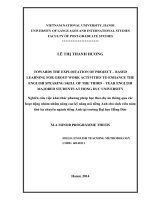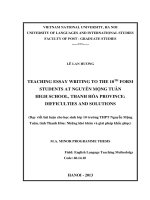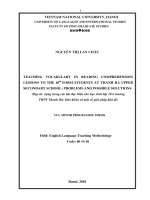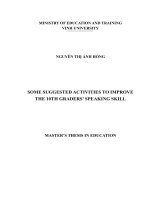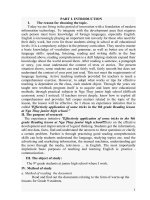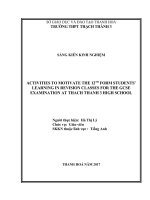Applying some useful speaking activities to enhance the 10th form students’ activeness at 4 tho xuan high school
Bạn đang xem bản rút gọn của tài liệu. Xem và tải ngay bản đầy đủ của tài liệu tại đây (217.14 KB, 20 trang )
SỞ GIÁO DỤC VÀ ĐÀO TẠO THANH HOÁ
TRƯỜNG THPT 4 THỌ XUÂN
EXPERIENCE INITIATIVE
APPLYING SOME USEFUL SPEAKING ACTIVITIES
TO ENHANCE THE 10TH FORM STUDENTS’ ACTIVENESS
AT 4 THO XUAN HIGH SCHOOL
Người thực hiện: Đỗ Thị Sen
Chức vụ: Giáo viên
Đơn vị công tác: Trường THPT 4 Thọ Xuân
SKKN thuộc lĩnh vực (môn): Môn Tiếng Anh
THANH HOÁ NĂM 2018
TABLE OF CONTENTS
-1
1. INTRODUCTION…………………………………………………………
1.1. Reasons for choosing the research……………………………………….
1.2. Aims of the research……………………………………………………..
1.3. Object of the research……………………………………………………
1.4. Methods of the research………………………………………………….
2. CONTENT……………………………………………………………………..
2.1. Theoretical background………………………………………………….
2.2. The reality of the problem…………………………………………...…...
2.3. Measure implementation…………………………………………………
2.3.1. Brainstorming …………………………………………………………
2.3.2. Information Gap Activities……………………………………………..
2.3.3. Playing Cards………………………………………………………….
2.4. Result……………………………………………………………………..
3. CONCLUSION AND SUGGESTIONS…………………………………...
3.1. Conclusion……………………………………………………………….
3.2. Suggestions………………………………………………………………
REFERENCES………………………………………………………………..
APPENDIX…………………………………………………………………...
Page
1
1
1
2
2
3
3
5
8
9
11
13
14
15
15
15
16
17
1. INTRODUCTION
-2
1.1. Reasons for choosing the research
English nowadays has become more and more popular and has been widely
used in Viet Nam. It is one of the major subjects in many schools and an
indispensable means of communication at present. It is also a "useful tool" and a
"master- key" to discover the world of science, technology, education, culture,
business and diplomacy. With such a trend of development, learning English is,
therefore, important than ever before. It is of such great importance that many
students are more and more interested in learning English. All learning is active in a
certain sense, but some kinds of learning are more active than others. Here, active
learning is defined in one sense to mean that the learner uses opportunities to
decide about aspects of the learning process. The stimulation of learning activities
and regulation processes, or teaching students how to learn, is likely to lead to the
best performance in the long run.
Speaking skill is a very important skill when learning English. Today’s world
requires that the goal of teaching speaking should improve students’
communicative skills, because, only in that way, learners can express themselves
and learn how to follow the social and cultural rules appropriate in teacher
communicative circumstances. Many language learners regard speaking ability as
the measure of knowing a language. These learners define fluency as the ability to
converse with others, much more than the ability to read, write or comprehend oral
language.
The real situation of English language teaching in Vietnam shows that speaking
is the skill students usually neglect and are not good at even though they have very
good grammatical knowledge. Students’ learning methods depend much on
teachers; students still are quite passive in their learning process. In order to
improve the students’ speaking ability, teachers can use many kinds of
communicative activities.
Being aware of this urgent problem, I have a great desire to study the current
activeness of students especially the 10 th form students at 4 Tho Xuan high school
and to investigate the learning activities in speaking lesson. That is the reason why
I choose the topic “Applying some useful speaking activities to enhance the 10 th
form students’ activeness at 4 Tho Xuan high school”.
1.2. Aims of the research
The aims of the research are:
- To investigate the situation of teaching and learning speaking to the 10 th graders in
classroom.
- To investigate the effectiveness of using games in teaching speaking to the 10 th
graders at 4 Tho Xuan high school.
-3
- To provide some suggestions and implications for the improvement of speaking
teaching at 4 Tho Xuan high school by using games in addition to other techniques.
1.3. Object of the research
The research focuses specifically on using games in warm up activity in
teaching speaking to the 10 th graders at 4 Tho Xuan high school, namely, 3 classes
10A2, 10A4 and 10A5.
1.4. Methods of the research
In the process of carrying out this research, the survey questionnaire is used to
collect data. The survey questionnaire including pre-task and post-task survey
questionnaire is for students from 3 classes 10A2, 10A4 and 10A5 at 4 Tho Xuan
high school.
-4
2. CONTENT
2.1. Theoretical background
Speaking, as Bygate (1997) definites, involves not only the use of the right
sound in the patterns of rhythm and intonation, but also the choice of words and
inflections in the right order to convey the right meaning.
O’Malley and Pierce (1996) states that speaking seems to be an important skill
that a learner should acquire. It is very important in order to enable students to
communicate effectively through oral language because the disability of the
students to speak may lead them to be unable to express their ideas even in a simple
form of conversation.
Common speaking activities
A variety of activities can be used to develop speaking skills. Below are some
common ones:
* Role play
* Information gap activity
* Problem – solving
* Other picture card activities
Motivation
Motivation is generally defined as an abstract concept used to describe the
willingness of a person to expand to reach a particular goal. For language learners,
mastery of a language may be a goal. In linguistic, sociolinguistic and second
language acquisition, a number of language learner motivation models have been
postulated.
Oxford and Shearin (1996) points out: “Motivation is important because it
directly influences how often use L2 learning strategies, how much students
interact with native speakers, how much input they receive in the language being
learnt (the target language), how well they do on curriculum-related tests, how high
their general proficiency level becomes, and how long they preserve and maintain
L2 skills after language study is over…”.
Language games
Language games mean games related to language. Hadfield (1987) classifies
language games into may categories as follow:
+ Sorting, ordering, or arranging games.
+ Information gap games.
+ Guessing games.
+ Search games.
+ Matching games.
+ Labeling games.
+ Exchanging games.
+ Board games.
+ Role play games.
-5
Definition of “Teaching speaking”
- The goal of teaching speaking skill is communicative efficiency.
- Learners should be able to make themselves understand, using their current
proficiency to the fullest. They should try to avoid confusion in the message due to
faulty pronunciation, grammar, or vocabulary, and to observe the social and cultural
rules that apply in each communicative situation.
- To help students develop communicative efficiency in speaking, teachers can use
a balanced activities approach that combines: language input, structured output and
communicative output.
- To use language as a means of expressing values and judgments and organize
their thought in a meaningful and logical sequence.
- To produce the English speech sounds and sound patterns.
- To use word and sentence stress, and intonation.
- To select appropriate words and sentences.
- To use the language quickly and confidently with few unnatural pauses, which is
called as fluency?
Guiding principles
The following principles are important to keep in mind when teaching speaking:
* The techniques should cover the range of learner’s needs from accuracy to
fluency.
* Speaking activities should be motivating to learners.
* Correction of learner errors should occur during speaking activities which are
accuracy-oriented not fluency oriented.
* Speaking activities should be integrated with other language skills.
* Students should be encouraged to not only answer questions but also to initiate
conversation and to take risks.
* Students should be provided with speaking strategies such as negotiating
meaning, asking for clarification, turn-taking etc.
* The teacher should design speaking activities which simulate real-life situations
so that students can learn how to speak naturally.
How to teach speaking
- Definitely, by “interacting”.
- Communicative language teaching and collaborative learning serve best of this
arm.
- Communicative language teaching should be based on real-life situations that
require communication. By using this method in English speaking language
classes, learners will have the opportunity of communicating with each other in the
target language.
- The teachers help students learn to speak so that the students can use speaking to
learn.
-6
2.2. The reality of the problem
General reality
English as a foreign language in Vietnam is taught in high schools as a
compulsory subject. Therefore, it is of great importance that we should take
students' English language learning into consideration. The implementation of
English teaching at present is based on the content standard. Its target is to help
students to reach an informational level. It means that school learners are expected
to be able to have adequate knowledge to use it to communicate with others in
English. In fact, the English instruction in some High schools does not demonstrate
a satisfactory result. Many students fail to reach the goal of the English teaching.
They are not able to communicate with the language either orally or in written form
although they have learned English for many years. Many of the learners in a
speaking class are reluctant speakers. This reluctance is partly due to their prior
learning experience. Many of them were educated in a large class in schools
situated in noisy neighborhoods where opportunities to speak are severely limited.
Others were taught in schools where speaking was simply not encouraged.
Moreover, in Viet Nam, many students are not fully interested in learning English
in class. On the one hand, they seem to be shy and fearful of making mistakes. On
the other hand, we lack a language environment and sufficient learning activities.
In that reality, there have many problems catching pedagogues' attention, i.e.,
how to organize learning activities effectively, how to develop interesting study
atmosphere in the classroom in order to enhance students' activeness in English
language learning.
The 10th form students at 4 Tho Xuan high school
Table 1: Result of the quality test at the beginning of the school year
Class Total Excellent
Number %
10A2 46
1
2,2
10A4
10A5
44
45
0
0
0
0
Good
Number %
12
26,1
8
10
18,2
22,2
Fair
Number
21
14
15
%
45,
6
31,8
33,3
Bad
Number %
12
26,1
22
20
50
44,5
The research was carried out at 4 Tho Xuan high school with the participation
of 135 the 10th form students. All of the surveyed students have learned English for
6 years. However, most of them have difficulties in mastering four language skills.
Of the four skills, as many of them revealed, they find speaking especially
important yet challenging one. That was the reason why most of the students feel
bored and unmotivated in speaking classes.
-7
The survey questionnaire used for students from 3 classes 10A2, 10A4 and
10A5 at 4 Tho Xuan high school.
Table 2: Students’ attitudes and perspectives towards speaking lessons
Options
Questions
Question 1:
How is speaking skill important to you?
A. Very important
B. Important
C. Normal
D. Not important at all
Question 2:
How do you find speaking topics introduced in
English 11 textbook?
A. Very interesting
B. Interesting
C. Normal
D. Boring
Question 3:
How do you find speaking activities introduced
in English 11 textbook?
A. Very difficult
B. Difficult
C. Normal
D. Easy
Question 4:
Are you willing to speak in speaking classes?
A. Yes, I like speaking very much
B. Yes, sometimes
C. No, I’m never willing to speak
A
(%)
B
(%)
C
(%)
D
(%)
8
17
25
50
10
21
23
46
62
27
11
0
1
28
71
As can be seen clearly from the above table, a lot of the surveyed students
think that speaking is the most difficult skill meanwhile there are only 8 % consider
speaking very important. More specifically, 46 % find speaking topics introduced
in English 10 textbook boring and 62% find speaking activities introduced in
English 10 textbook very difficult. Moreover, there are so many students who are
never willing to speak in speaking classes (71%). In summary, the students are
losing their interest during the lesson. Therefore, an effective technique should be
exploited to motivate students in these speaking lessons.
-8
Table 3: A summary of students' activeness in English speaking learning
Students' activeness in
English speaking learning
Students' responses
(%)
1. The level of students' involvement in the
speaking lesson
Very active
Quite active
Little active
Not active at all
5,2
13,6
26,5
54,7
2. The reasons for students not involving in English
speaking activities
Nervousness and shyness
Inefficient learning activities
Insufficient English knowledge
Not speaking English fluently
Others
20,8
12,6
47,3
19,3
0
3. Students' willingness for communication and
discussion the tasks with others
Yes
No
23,5
76,5
4. The frequency of finding chances to
practice English inside and outside classroom
Frequently
Sometimes
Rarely
Never
7,5
18,3
30,2
44
The data collected from the students' questionnaire and classroom observation
give us an overview of the activeness of the 10 th form students in learning speaking
English. According to what is shown from the table 3, it can be realized that a
small number of the 10th form students enjoy learning speaking English while there
are still a lot of the students who have a negative attitude towards English speaking
learning.
-9
Obviously, students nowadays have a clear awareness of English learning; they
learn it not because they are forced to study but because they are conscious of the
importance and necessity of English at present. Therefore, in order to help students
learn English effectively, the enhancement of students' activeness in English
speaking learning is of paramount importance.
2.3. Measure implementation
Traditional classroom speaking practice often takes the form of drills in which
one person asks a question and another gives an answer. The question and the
answer are structured and predictable, and often there is only one correct,
predetermined answer. The purpose of asking and answering the question is to
demonstrate the ability to ask and answer. In contrast, the purpose of real
communication is to accomplish a task, such as conveying a telephone message,
obtaining information or expressing an opinion. In real communication, participants
must manage uncertainty about what the other person will say. Authentic
communication involves an information gap; each participant has information that
the other does not have. In addition, to achieve their purpose, participants may have
to clarify their meaning or ask for confirmation of their own understanding.
To create classroom speaking activities that will develop communicative
competence, teachers need to incorporate a purpose and an information gap and
allow for multiple forms of expression. However, quantity alone will not
necessarily produce competent speakers. Teachers need to combine structured
output activities, which allow for error correction and increased accuracy, with
communicative output activities that give students opportunities to practice
language use more freely.
In classroom, besides active students some of them are still passive in the
learning process. It is the teachers' duty to evoke these students' interests,
encourage their involvement in classroom activities.
To lessen the students' fear of making mistakes and shyness, teachers should
increase students' confidence by encouraging them to contribute their ideas to the
lesson. Teachers may give them some cues for the answers and express satisfaction
and excitement about their ideas even silly answers. It is essential that teachers
should use open- ended questions as much as possible that many answers are
acceptable. This makes students to be more confident and less afraid of making
mistakes.
* The following activities are used frequently in speaking lesson:
- Discussions
- Reporting
- Role-play
- Simulations
- Story telling
- Picture describing
- 10
- Interviews
- Picture narrating
During my teaching time, I realized that the above activities are sometimes too
difficult for “weak” students to participate. In this initiative, therefore, I mention
some other speaking activities in order to enhance the 10 th form students’
activeness.
2.3.1. Brainstorming
On a given topic, students can produce ideas in a limited time. Depending on the
context, either individual or group brainstorming is effective and learners generate
ideas quickly and freely. The good characteristics of brainstorming are that the
students are not criticized for their ideas so students will be open to sharing new
ideas.
+ Aims:
Brainstorming helps students recall vocabulary, structures, expressions related
the given topic.
+ Advantages:
- Brainstorming is a creative process that can be undertaken individually but is
mainly used in a group setting.
- It is used to work through ideas to find a solution to a problem or situation.
- It is a powerful way to generate, share and maximize new ideas.
- Brainstorming provides many advantages to the process of sorting through
problems.
+ Example:
Unit 1: A day in the life of … - Lesson B < Speaking >
Task 3: Tell your classmates about your daily routine
Aim: Let the students practice talking about daily life.
Teaching aids: extra-board
Time: 15 minutes
Procedure:
- 11
- Step 1 (1 minute): The teacher divides the class into groups of five or six. Each
group selects a leader who controls the group and takes notes the ideas of the other
students.
- Step 2 (4 minutes): The teacher has the students to list vocabulary and structures
about daily routine.
- Step 3 (2 minutes): The teacher asks the representatives of each group to hand in
their lists and decides which group has the best list.
- Step 4 (3 minutes): The teacher hangs an extra-board (vocabulary and structures
about daily routine) and has the students to work in pairs to tell about their daily
routine.
- 12
- Step 5 (4 minutes): The teacher calls some students to represent in front of the
class.
- Step 6 (1 minute): The teacher comments.
2.3.2. Information Gap Activities
Information Gap Activities require students to communicate with each other in
order to find all the necessary information to complete the activity. Each partner
has information that the other does not. It is very important that students have the
appropriate level of language in order to complete the activity. There is sometimes
a lot of repetition in the communication as students try to narrow down the
information. This can be very useful when the teacher wants the students to focus
on a particular structure. Here is an example of an activity where students first
choose their “secret” information that their partner must then discover.
+ Aims:
Information gap activities force the students to ask each other questions; these
activities help make the classroom experience more meaningful and authentic.
+ Advantages:
Information gap activities are useful because they are very meaningful; all students
are involved in the process equally and they are all moving towards a specific
- 13
purpose. Each student has the task of finding out certain information, and therefore
must find a way in which to ask for this information. Motivation is usually quite
high in these activities. These activities help move the students from working in a
more structured environment into a more communicative environment; they are
hopefully using lots of the target language, and in the process discovering where
they have gaps. Knowing where these gaps are gives them a direction in which to
improve.
+ Example:
Unit 11: National parks – Lesson B < Speaking >
Task 3: Work in pairs. Ask and answer questions to complete your table.
Aim: Using conditional sentence type 3 to express the regrets about what someone
did or did not do in the past.
Teaching aids: worksheets
Time: 15 minutes
Procedure:
- Step 1 (2 minutes): The teacher divides the class into pairs and gives each pair 2
worksheets; each student gets one (A or B).
A
Name
Hoa
Nam
Lan
Minh
Thuy
Condition
If she hadn’t got up late
Result
he would have got good marks
If she had had enough money
he wouldn’t have had the accident
If she hadn’t passed the exam
B
Name
Hoa
Nam
Lan
Minh
Thuy
Condition
Result
she wouldn’t have missed the train
If he had tried in Math
she could have bought the book
If he had driven carefully
her parents would have been disappointed
The students may ask and answer:
Student A: What would have happened if Hoa hadn’t got up late?
Student B: If she hadn’t got up late, she wouldn’t have missed the train.
Or:
Student B: Hoa wouldn’t have missed the train if what had happened?
- 14
Student A: She wouldn’t have missed the train if she hadn’t got up late.
- Step 2 (5 minutes): The teacher has the students to ask and answer questions in
order to find all the necessary information to complete their table in 5 minutes. The
teacher goes around and observes the class.
- Step 3 (5 minutes): The teacher calls on some students to read the complete
sentences.
- Step 4 (3 minutes): The teacher calls on some other students to comment and then
gives feedback.
2.3.3. Playing Cards
In this game, students should form groups of four. Each student in a group will
choose a card. Then, each student will write 4-5 questions about that topic to ask
the other people in the group. However, the teacher should state at the beginning of
the activity that students are not allowed to prepare yes-no questions, because by
saying yes or no students get little practice in spoken language production. Rather,
students ask open-ended questions to each other so that they reply in complete
sentences.
+ Aims:
It's a way to encourage your students to speaking about everyday topics and interact
with the rest of the group and not just the teacher.
+ Example:
Unit 2: School talks – Lesson B < Speaking >
Task 4: Work in pairs. Make small talks, using the starting and ending of a
conversation.
Aim: Fluency in expressing opinions and making conversations.
Teaching aids: cards
Time: 15 minutes
Procedure:
- Step 1 (2 minutes): The teacher divides the class into groups of four and gives
each group four cards:
* Diamonds: The weather
* Hearts: Last night’s TV programmes
* Spades: Football
* Clubs: Plans for next weekend
- Step 2 (3 minutes): Each student in a group will choose a card. Then, each student
will write 4-5 questions about that topic to ask the other students in the group. For
instance:
If the topic "Diamonds: The weather" is selected, here are some possible questions:
* What’s the weather like today?
* What’s the weather like in the spring/ summer/ autumn/ winter?
- 15
* What’s the weather like in your country/ hometown?
* What weather do you like? Why?
* What do you often do when it’s warm/ hot/ cool/ cold?
- Step 3 (5 minutes): The teacher lets the students talk with each other about the
topics.
- Step 4 (4 minutes): The teacher calls some pairs to represent in front of the class.
- Step 5 (1 minute): The teacher comments and gives feedback.
2.4. Result
After using the above activities in speaking lessons for the 10th grade, I realized
that there have been some considerable changes such as:
+ The atmosphere of the class became more ebullient; the students were eager to
participate in speaking activities and active to contribute their ideas to the lesson.
+ The students were more confident and less afraid of making mistakes.
The progress of the students can be seen through the following tables comparing
the studying results between the time before and after using some useful speaking
activities.
Table 1: Result of the quality test at the beginning of the school year
(Before using some useful speaking activities)
Class Total Excellent
Number
10A2 46
1
10A4 44
0
10A5 45
0
%
2,2
0
0
Good
Number
12
8
10
%
26,1
18,2
22,2
Fair
Bad
Number % Number %
21
45,6
12
26,1
14
31,8
22
50
15
33,3
20
44,5
Table 4: Result of the quality test at the end of the school year
(After using some useful speaking activities)
Class Total Excellent
Good
Number
% Number
10A2 46
5
10,9
20
10A4 44
1
2,3
11
10A5 45
2
4,4
19
5
%
43,5
25
42,2
5
Fair
Bad
Number % Number %
16
34,7
5
10,9
22
50
10
22,7
15
33,3
9
20
- 16
3. CONCLUSION AND SUGGESTIONS
3.1. Conclusion
Teaching speaking is a very important part of second language learning. The
ability to communicate in a second language clearly and efficiently contributes to
the success of the learner in school and success later in every phase of life.
Therefore, it is essential that language teachers pay great attention to teaching
speaking. Rather than leading students to pure memorization, providing a rich
environment where meaningful communication takes place is desired. With this
aim, some useful speaking activities such as those listed above can contribute a
great deal to students in developing basic interactive skills necessary for life. These
activities make students more active in the learning process and at the same time
make their learning more meaningful and fun for them.
3.2. Suggestions
In this experience initiative, I have studied some useful speaking activities to
enhance the 10th form students' activeness at 4 Tho Xuan high school. Based on the
data collected from the document study, classroom observation and questionnaires I
have come to the conclusion that students now are quite active in learning speaking
English. They have positive attitude towards learning English because they are
aware of the important role of learning English nowadays. The role of the teacher
and classroom atmosphere are important to students' language learning. Teacher is
not a controller but an organizer instead. On the basis of what are found, I put
forward some implications and suggestions for enhancing students' activeness in
learning English in a hope that students will be more active and creative in English
language learning.
Xác nhận của hiệu trưởng
Thọ Xuân, ngày 20 tháng 05 năm 2018
Tôi xin cam đoan đây là SKKN của mình viết,
không sao chép nội dung của người khác.
Người viết SKKN
Đỗ Thị Sen
- 17
REFERENCES
1. Hoang Van Van (2006), Tiếng Anh 10, NXB Giáo Dục.
2. Cẩm nang dạy và học tiếng Anh trung học phổ thông - NXB Giáo dục 2007
3. Chuẩn kiến thức kỹ năng môn Tiếng Anh 10 – (Tái bản lần thứ nhất) - NXB
Giáo dục Việt Nam 2010.
4. Thiết kế hoạt động dạy và học Tiếng Anh 10, tập II, NXB Giáo dục Hà Nội.
5. Thiết kế bài giảng Tiếng Anh 10, NXB Hà Nội 2009.
6. Lê Văn Sự, English methodology, Hanoi 2005.
7. Littlewood, W. (1990), Communicative Language Teaching, an Introduction,
Cambridge University Press.
8. Brophy, Jeremy (1998), Motivating Students to Learn, Mc Graw- Hill
Companies.
- 18
APPENDIX
BẢNG TRƯNG CẦU Ý KIẾN HỌC SINH
Bảng trưng cầu ý kiến này nhằm giúp cho việc nghiên cứu “ Làm thế nào để nâng
cao tính tích cực của học sinh lớp 10 trong giờ học tiếng Anh qua một số hoạt động
nói”.
Xin vui lòng đọc kỹ và trả lời các câu hỏi dưới đây : đánh dấu ( x) vào những ô mà
bạn cho là đúng nhất .
1. Bạn có thích học Tiếng Anh không ?
□Có
□ Không
2. Theo bạn học Tiếng Anh :
□Rất quan trọng
□Ít quan trọng
□Không quan trọng
3. Trong giờ học nói Tiếng Anh, bạn như thế nào ?
□ Rất tích cực
□ Ít tích cực
□ Khá tích cực
□ Không tích cực
4. Lý do nếu bạn không tham gia vào các hoạt động nói trong lớp ?
□ Lo lắng e thẹn
□ Các hoạt động học không hiệu quả
□ Kiến thức về ngôn ngữ Tiếng Anh ít
□ Nói Tiếng Anh không trôi chảy
5. Bạn có muốn giao tiếp hay thảo luận bài tập với các bạn khác trong lớp hay
không ?
□ Có
□ Không
6. Bạn có thường tự tạo cơ hội cho mình để thực hành Tiếng Anh trong và ngoài
lớp học không?
□ Thường xuyên
□ Hiếm khi
□ Thỉnh thoảng
□ không bao giờ
7. Bạn cảm thấy thích học Tiếng Anh khi nào ?
□ Tham gia một cách tích cực vào các hoạt động học
□ Chú ý tới bài giảng của Giáo viên
□ Nhận những ý kiến phản hồi từ Giáo viên
□ Các hoạt động hay và ý nghĩa
□ Giáo viên đưa ra nhưng yêu cần cao về bài tập
- 19
□ Ý kiến khác…………………………………………………………….
Cảm ơn sự hợp tác của các em rất nhiều!
DANH MỤC
CÁC ĐỀ TÀI SÁNG KIẾN KINH NGHIỆM ĐÃ ĐƯỢC HỘI ĐỒNG ĐÁNH
GIÁ XẾP LOẠI CẤP PHÒNG GD&ĐT, CẤP SỞ GD&ĐT VÀ CÁC CẤP
CAO HƠN XẾP LOẠI TỪ C TRỞ LÊN
Họ và tên tác giả: ĐỖ THỊ SEN
Chức vụ và đơn vị công tác: Giáo viên – Trường THPT 4 Thọ Xuân
TT
1
2
Tên đề tài SKKN
Using some language games in
warm up activity effectively
to motivate the 11th graders at 4
Tho Xuan high school
in English speaking classes
Using some language games
effectively in warm up activity
to motivate the 10th graders at 4
Tho Xuan high school
(the first term of English 10 –
basic)
Cấp đánh
giá xếp loại
(Phòng, Sở,
Tỉnh…)
Kết quả
đánh giá
xếp loại
(A, B
hoặc C)
Năm học đánh
giá xếp loại
SỞ GD&ĐT
C
2015 - 2016
SỞ GD&ĐT
C
2016 - 2017
- 20



